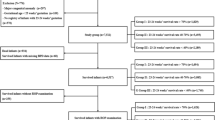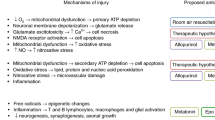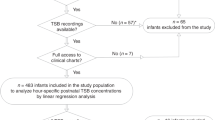Abstract
OBJECTIVE: Bilirubin is a potent in vitro antioxidant. Despite repeated study, its in vivo significance has yet to be defined. Bilirubin is universally elevated in very low birthweight (VLBW) infants. Retinopathy of prematurity (ROP) is a disease thought to be associated with exposure to oxygen free radicals in VLBW infants. The objective of this study was to determine whether there was an association between peak bilirubin levels and ROP.
METHODS: The risk for ROP, stages III and IV was measured as a function of increasing peak bilirubin levels in VLBW infants admitted to the neonatal ICU. A similar analysis was performed on a subgroup of VLBW infants with prolonged (≥28 days) oxygen requirement. The relation between peak bilirubin level and the duration of oxygen requirement was tested by logistic regression analysis. All analyses were conducted after controlling for birthweight and presence of intraventricular hemorrhage (IVH).
RESULTS: There was an increased risk for ROP, stages III and IV (OR 1.187; 95% CI 1.013 to 1.390; p=0.034) with elevated peak serum bilirubin levels in the entire population. Duration of oxygen requirement was not related to peak bilirubin (p>0.1). In the subgroup of infants with prolonged oxygen requirement (≥28 days), there was no association between peak serum bilirubin levels and ROP III and IV (p>0.1); however, there was an association with further increased duration of oxygen requirement (p=0.034).
CONCLUSION: Elevated peak bilirubin does not protect from and may be a risk for ROP in VLBW infants.
This is a preview of subscription content, access via your institution
Access options
Subscribe to this journal
Receive 12 print issues and online access
$259.00 per year
only $21.58 per issue
Buy this article
- Purchase on Springer Link
- Instant access to full article PDF
Prices may be subject to local taxes which are calculated during checkout
Similar content being viewed by others
References
Stocker R, Yamamoto Y, McDonagh AF, Glazer AN, Ames BN . Bilirubin is an antioxidant of possible physiologic importance. Science 1987;71:233–238.
Kozaki N, Shimizu S, Chijiiwa K, et al. Bilirubin as an anti-oxidant for surgical stress: a preliminary report of bilirubin oxidative metabolites. HPB Surg 1999;11(4):241–248.
Dennery PA, McDonagh AF, Spitz DR, Rodgers PA, Stevenson DK . Hyperbilirubinemia results in reduced injury in neonatal Gunn rats exposed to hyperoxia. Free Radical Biol and Med 1995;19:395–404.
Hegyi T, Goldie E, Hiatt M . The protective role of bilirubin in oxygen-radical diseases of the preterm infant. J Perinatol 1994;XIV:296–300.
Yeo KL, Perlman M, Yong H, Mullaney P . Outcomes of extremely premature infants related to their peak serum bilirubin concentrations and exposure to phototherapy. Pediatrics 1998;102:1426–1431.
Benaron DA, Bowen FW . Variation of initial serum bilirubin rise in newborn infants with type of illness. Lancet 1991;338:78–91.
Heyman E, Ohlsson A, Girschek P . Retinopathy of prematurity and bilirubin. N Eng J Med 1989;320:256.
Fauchere JC, Meier-Gibbons FE, Koerner F, Bossi E . Retinopathy of pre maturity and bilirubin — no clinical evidence for a beneficial role of bilirubin as a physiological anti-oxidant. Eur J Pediatr 1994;153:358–362.
Gaton DD, Gold J, Axer-Siegel R, Wielunsky E, Naor N, Nissenkorn I . Evaluation of bilirubin as possible protective factor in the prevention of retinopathy of prematurity. Br J Ophthalmol 1994;75:532–534.
DeJonge MH, Khuntia A, Maisels MJ, Bandagi A . Bilirubin levels and severe retinopathy of prematurity in infants with estimated gestational ages of 23 to 26 weeks. J Pediatr 1999;135:102–104.
Drury JA, Nycyk JA, Baines M, Cooke RW . Does total antioxidant status relate to outcome in very preterm infants? Clin Sci 1998;94(2):197–201.
Romeo MG, Tina LG, Scuderi A, Di Pietro M, Caracciolo M, Distefano G . Variations of blood bilirubin levels in the newborn with and without retinopathy of prematurity (ROP). Pediatr Med Chir 1994;16:59–62.
Teng RJ, Wu TJ, Yau KI . Retinopathy of prematurity in very-low-birthweight neonates: Epidemiology and risk factors. Chung-Hua Min Kuo Hsiao Erh Ko i Hsueh Hui Tsa Chih 1997;38(5):370–374.
Epstein MF, Leviton A, Kuban KCK, et al. Bilirubin, intraventricular hemorrhage, and phenobarbital in very low birth weight babies. Pediatrics 1988;82:350–354.
Kohelet D, Goldberg M, Arbel E . Factors affecting plasma bilirubin in preterm infants ventilated for respiratory distress syndrome. J Perinatol 2000;5:285–287.
Dennery PA, Rodgers PA, Lum Melissa A, Jennings BC, Shokoohi V . Pediatr Res. 1996;40:815–821.
Hommura S, Usuki Y, Takei K, et al. Ophthalmic care of very low birth weight infants, report 4: clinical studies of the influence of light on the incidence of ROP. Nippon Ganka Gakkai Zasshi. 1998;92:456.
Glass P, Avery GB, Subramanian KNS, Keys MP, Sostek AM, Friendly DS . Effects of bright light in the hospital nursery on the incidence of retinopathy of prematurity. N Engl J Med. 1985;313:401–404.
Reynolds JD, Hardy RJ, Kennedy KA, Spencer R, van Heuven WAJ, Fielder AR . Lack of efficacy of light reduction in preventing retinopathy of prematurity. N Engl J Med. 1998;338:1572–1576.
Ackerman B, Sherwonit E, Williams J . Reduced incidental light exposure: effect on the development of retinopathy of prematurity in low birth weight infants. Pediatrics 1989;83:958–962.
Acknowledgements
We express our deep appreciation to Cheng Shao, MD, MPH at the Children's Research Institution for her help with the statistical analysis.
Author information
Authors and Affiliations
Rights and permissions
About this article
Cite this article
Milner, J., Aly, H., Ward, L. et al. Does Elevated Peak Bilirubin Protect from Retinopathy of Prematurity in Very Low Birthweight Infants. J Perinatol 23, 208–211 (2003). https://doi.org/10.1038/sj.jp.7210887
Published:
Issue Date:
DOI: https://doi.org/10.1038/sj.jp.7210887
This article is cited by
-
Role of Birth Order in the Development of Retinopathy of Prematurity in Multiple Gestation: a Study of 1040 Asian Indian Premature Infants
SN Comprehensive Clinical Medicine (2022)
-
The role of hepatic and renal functions in the development of retinopathy of prematurity: Is proteinuria a new risk factor?
International Ophthalmology (2022)
-
Complete blood count parameters to predict retinopathy of prematurity: when to evaluate and what do they tell us?
International Ophthalmology (2021)



